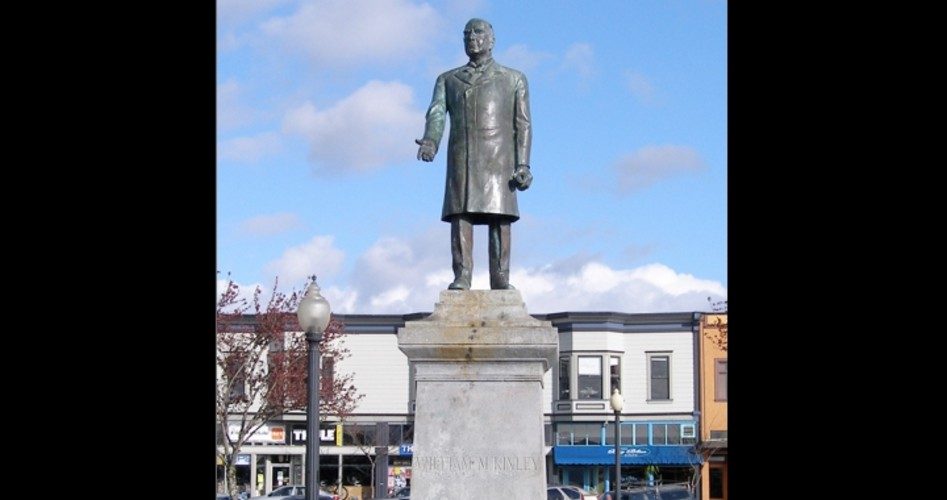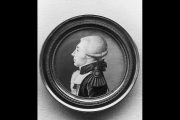
The iconoclastic vendetta being waged by radical leftists against historic statues, monuments, and observances across America shows no signs of abating. Most such cultural attacks have been aimed at Confederate generals such as Robert E. Lee. But now we can add the formerly uncontroversial U.S. President William McKinley to the list of historic figures whose statues the politically correct want removed.
In past articles in The New American, we observed (in 2014 and 2015) that Columbus Day was being replaced with “Indigenous People’s Day” in some cities. Last year, several articles posted by this magazine reported about the misguided decision by the Charlottesville, Virginia, city council to remove the statue of Confederate General Robert E. Lee — a move that led to violent confrontations between supporters and opponents of the decision, as the voices of moderation representing most residents of Charlottesville were drowned out by imported white supremacists and violent “Antifa” extremists.
That controversy had barely settled down when on May 19, 2017, the Robert E. Lee monument in New Orleans, which was dedicated in 1884, was removed from its place of honor to an undisclosed location. Despite the fact that Lee had freed the slaves he had inherited, and was opposed to Virginia seceding from the Union, his decision to defend his native state by assuming the command of the Confederate army is somehow deemed by historical revisionists as “racist.” But the politically correct seldom display logic when making their demands.
The latest target of the iconoclasts is a statue of President William McKinley that has stood in the central plaza in Arcata, California, since 1906. McKinley’s presidency was not without controversy. He imposed the 1890 McKinley Tariff, promoted the 1897 Dingley Tariff, and — most significantly — led the nation into the Spanish-American War in 1898. But none of those policies prompted the current movement against the McKinley statue in Arcata.
The protesters object, instead, to what they perceive as McKinley’s objectionable treatment of Native Americans.
The Los Angeles Times quoted Chris Peters, who heads an Arcata-based group called the Seventh Generation Fund for Indigenous People. “Put a rope around its neck and pull it down,” Peters shouted at a recent rally held at the McKinley statue.
Peters called McKinley a proponent of “settler colonialism” that “savaged, raped and killed.”
The Times reported that last February, during a long and heated city council meeting, dozens of residents packed Arcata City Hall to testify on both sides of the issue. In the end, the council voted 4-1 to get rid of the statue.
“Is there a difference between honoring McKinley and Robert E. Lee?” the mayor, Sofia Pereira, who was part of the majority, said during a recent interview. “They both represent historical pain.”
However, former Arcata Mayor Bob Ornelas, who has lived in the city since 1979, said tearing down the McKinley statue would take away from the city’s culture. He said he couldn’t imagine the square, home to the Saturday farmers’ market and nearly every major city festival, without the McKinley statue there.
“I don’t read much into it,” said Ornelas, who is Mexican-American. “It’s not Robert E. Lee. If it was somebody who is known to fight their cousins for the right to have a slave, I would be offended. But during his time he got pushed around by a Congress that was hungry for … expanding the American empire.”
Ornelas’ statement was historically inaccurate, since Lee never fought for anyone’s right to own a slave, but to defend his native Virginia from Union forces. However, since McKinley served in those same Union forces, it seems even less logical for there to be so much sentiment against him.
However, Ornelas’ wife, Susan, sees things differently from her husband. Mrs. Ornelas is presently a councilwoman, but was mayor last year when the push to remove the statue surfaced.
“We are in a small northern part of Northern California where Native people are active in our lives daily,” Susan Ornelas said. “It’s not just a lost thought. McKinley didn’t back Native Americans at all. He backed the Curtis Act, which took away Native rights on a lot of land. Natives were so misused in that era. He didn’t really directly hurt them locally but he did through federal laws.”
The Curtis Act of 1898 was an amendment to the Dawes Act that resulted in the break-up of tribal governments and communal lands in Indian Territory (now Oklahoma). By effectively abolishing the remainder of tribal courts, tribal governments, and tribal land claims in the Indian Territory of Oklahoma, the act enabled Oklahoma to be admitted as a state in 1907.
While in retrospect, the Curtis Act may not have been beneficial to members of the Indian tribes, it was by no means atypical of U.S. government policy in the 19th century. Furthermore, the author of the legislation, Kansas Representative Charles Curtis, who was later elected to the Senate and then became vice president under Herbert Hoover, had considerable Native American ancestry. It is, therefore, a considerable stretch to say that McKinley’s decision to sign the act was indicative of hostile, anti-Native American inclinations.
Arcata is not the only community in California where politically correct activists have worked to remove a statue they deem to be insulting to Native Americans. Last month, San Francisco’s Arts Commission voted unanimously to have a statue named “Early Days,” which is part of the larger bronze and granite Pioneer Monument located between the city’s Main Public Library and the Asian Arts Museum, removed. American sculptor Frank Happersberger was commissioned for the work, which he completed in 1894.
The supposedly objectionable feature of the statue is that it depicts a Native American lying backward on the ground, resting on his arms before a Spanish missionary, whose arm is raised above him with index finger extended as if reciting a lesson or maybe even giving the Indian his blessing. A Spanish vaquero (cowboy) stands next to the padre, but looks off into the distance. Those who object to the statue claim it depicts a Native American “cowering” before the Spaniards, but that interpretation is entirely subjective.
Since interpretation of art is often subjective, it is perilous to give veto power over a statue’s display to anyone who claims to find a public work of art to be “offensive.” That is particularly the case if the artwork has stood for many years without previous objections. It such cases, there is good reason to suspect that those who demand its removal have a political agenda.
Photo: Statue of William McKinley in Arcata, California, by J. Scott Shannon
Related articles:
Attacks Upon Robert E. Lee Statues Betray Historical Ignorance
Lawsuit Aims to Stop Removal of General Robert E. Lee Statue
Killing Columbus: Seeking the “Undiscovery” of America
Attacking America: Columbus Day Being Replaced With “Indigenous Peoples Day”
Killing Columbus: Seeking the “Undiscovery” of America
Columbus Day Renamed “Indigenous People’s Day” by Some Cities



